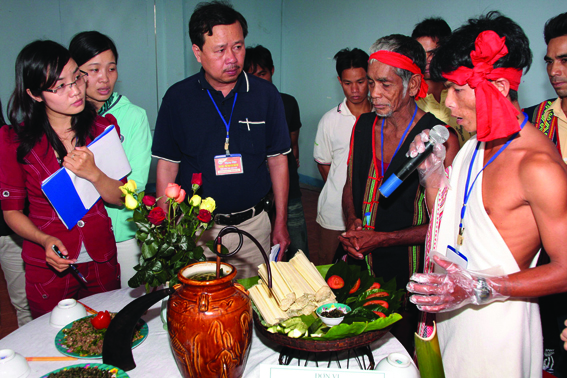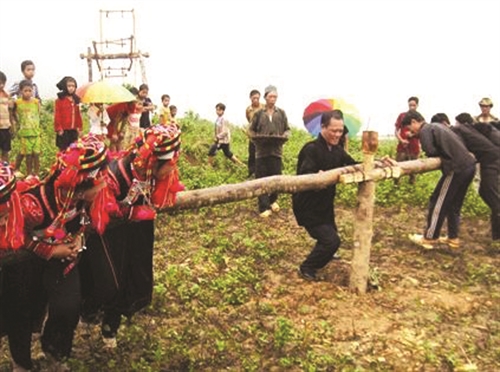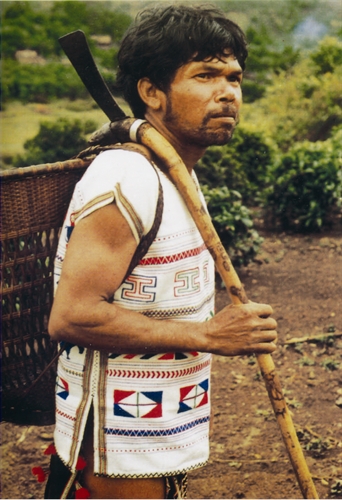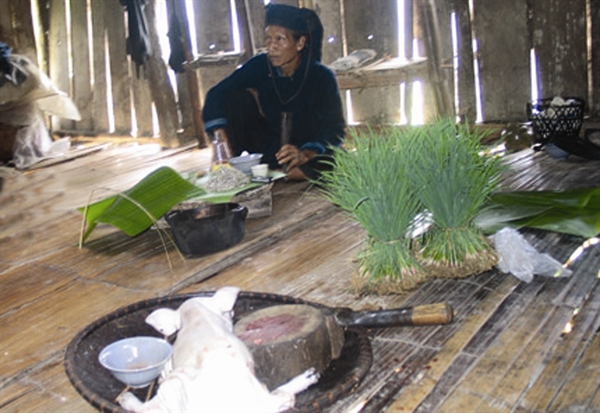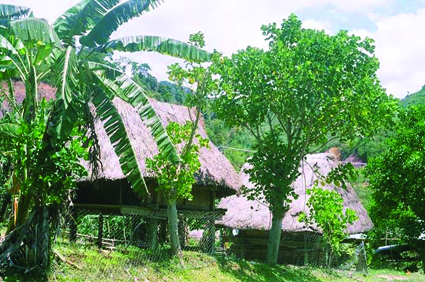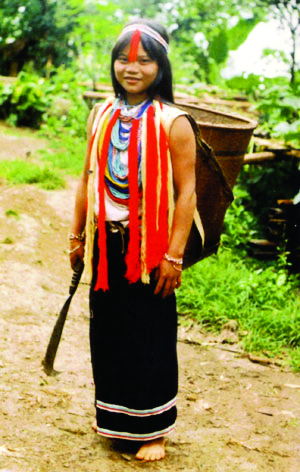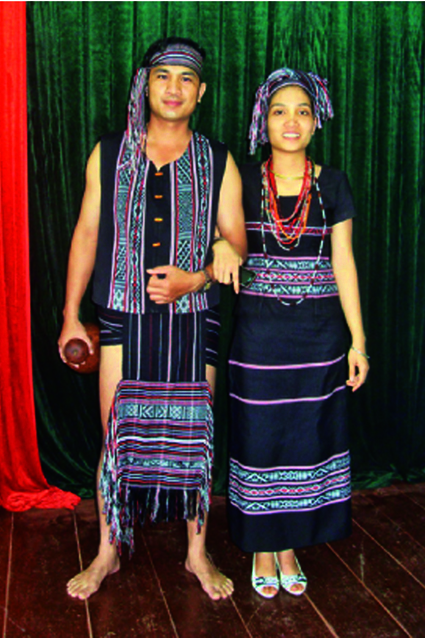Ta Thi Tam
Ethnology Institute
The Ro Mam, one of the three smallest ethnic groups (Brau, O Du and Ro Mam) in Vietnam, live in Sa Thay area bordering on Laos and Cambodia in the Central Highlands province of Kon Tum.
With a tiny population of around 400, this Mon-Kh’mer language group lives on farming, choosing old-growth forests to clear land for cultivation. The group grows sticky rice as the main crop with simple farming methods. To sow seeds, a man pricks holes with two sticks in his two hands, followed by a woman who sows seeds and buries the holes. The group also grows ordinary rice, maize, cassava, tobacco, vegetables such as bean, pumpkin, sweet potato and fruits, including papaya, mango and banana.
The Ro Mam raise buffalos, pigs, chickens and ducks for food and sacrifice in community rituals. Hunting and picking up forest products are another source of food supply for the group.
The Ro Mam are good at weaving and used to make clothes themselves. At present the group uses industrial cloth to make clothing.
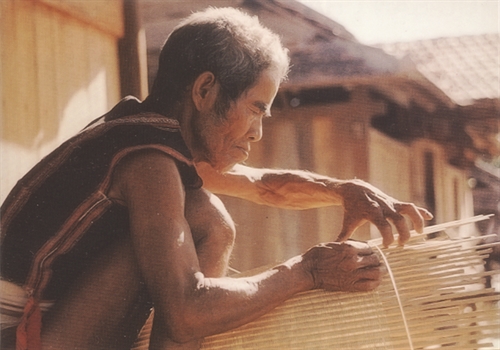 |
| An old Ro Mam man __Photo: VNA file |
A Ro Mam village is called de which is surrounded by a fence to ward off wild beasts and cattle from other villages. A de has six gates with the main entrance gate facing the North. Two other gates are opened to the East leading to Sa Thay river and another two face the South. The last gate looks to the West which leads to the village graveyard.
Houses in the village are arranged in a closed oval in the middle of which is nha rong (communal house) where community rituals and events are held. Nha rong is a stilt-house with three parts. It has a simple frame made of four beams and twelve props which are tied together with liana. The communal house has bamboo walls without any window and a stair leading to the middle part.
In the past, members of a village used to come from a same family line but are now from other groups such as the Bru and Gia Rai as a result of the Ro Mam’s exogamy practice. A de is headed by an old man who is elected by villagers for his wisdom and prestige. The village head decides on all community affairs with the aid of kaik nay and kaik no, who are also prestigious old men.
The Ro Mam’s home is a long stilt-house which accommodates several extended families. Its structure is typical of stilt-houses in the Central Highlands with wood beams and props. The two-roof house has bamboo walls and a relatively low floor. It also has another open floor where the rice mortar is placed. The house is divided along into two parts with a passage in the middle. The front and back parts are further divided into rooms for member families. The middle part is for receiving guests and common activities of member families.
Though living in the same house, member families are economically independent, doing farming and raising animals on their own. In a Ro Mam patriarchal family, the father decides on all family affairs.
The Ro Mam traditional costume, especially that of women, shows the group’s preservation of its traditional values. A Ro Mam man wears a white loincloth with the front flap falling down to the knees and the back flap, down to the ankles. Ro Mam men, especially the elderly, have tattoos on their backs. They also wear brass bracelets.
The costume of a Ro Mam woman consists of a long dress below the knees, which is gracefully decorated with colorful hems, a short sleeve shirt with red hems on the collar, sleeves and fringe, and a scarf. Ro Mam women like wearing ivory earrings, twisted brass bracelets and bead necklaces. In the past, a Ro Mam had to take cua rang (tooth cutting) to be recognized as an adult but this backward practice is now abandoned.
Ro Mam people get married at the age of 16-18. Young people are free in love but must get parental consent to their marriage. A Ro Mam marriage undergoes through two formalities: the proposal ceremony (nam muan) and the wedding (et gu). The groom’s parents ask an elderly man to act as the matchmaker of the marriage. Offerings of the proposal ceremony, which is held at nha rong, include a pig, two chickens and a jar of wine. For this ceremony, the two families each prepare a bracelet as the betrothal present for their child-in-law which is given by the matchmaker on their behalf. The wedding, held at the groom’s family, is attended by all villagers who toast the couple for their lifelong happiness.
A Ro Mam mother prepares every thing for her delivery. She has to give birth in a separate place next to her home as the delivery is believed to make the home spiritually dirty. In the Ro Mam belief, a pregnant woman is not supposed to go to a forest, climb a mountain, pass a cemetery, or attend a funeral to protect her baby. A Ro Mam woman sits when giving birth with the help of a village midwife. The newborn is bathed in warm water before being swaddled. The placenta is buried in the forest. The baby is named only after his umbilical stump drops off. The Ro Mam has a taboo of naming a child identical to that of a villager. When the child is one month old, the family holds a ceremony to recognize its new member during which the mother and child bathe in water in which forest leaves have been boiled.
A Ro Mam funeral usually lasts two or three days. When a member dies, the family places the dead in a coffin in front of the house with his head turning to the home. The coffin is made of two hollow halves of a two-meter log put on together. The family conducts a ceremony dedicated to the gods and ancestors to pray for the dead, then invites mourners to a meal. The dead is buried at the village graveyard. The Ro Mam do not build a graveyard to the East for fear that death will pass the village in the direction of the sun. The dead is buried in a direction that avoids his face looking to the village to keep the village away from misfortunes. The grave is built carefully, having four wood props beautifully carved in the shape of ivory.
The Ro Mam believe every creature has a spirit called Jang. In their belief, a person is healthy when Jang stays inside him and gets sick when Jang leaves him and a ceremony must be conducted to call Jang back. A person dies when Jang leaves him and is captured by evil spirits.
The Ro Mam’s biggest festival is the barn-opening ceremony held at the year end when all harvested rice is brought to the barn in the field. The festival, which marks the end of a production cycle, is held in three days. From early morning on the first day, every family brings offerings, which include a pig, some chickens and wine, to the field to carry out a formality to open the barn. After making a symbolic bridge for the rice spirit to go home, the family head recites prayers to invite the rice spirit home. He then pours wine in front of the barn and splashes the blood of the sacrifice animal onto the gate of the barn before opening it for his wife to take the first basket of rice. After that, other family members carry rice home. Then comes a community ritual conducted by the village head in nha rong in the presence of all family heads. When the ritual finishes, every villager brings home fire taken from the sacred fire in nha rong to light his stove to cook the new rice.
In the afternoon, villagers erect a pole in preparation for the buffalo stabbing ceremony held the next day. The sacrifice buffalo, which has been selected carefully and raised separately for months before the festival, is then tied to the pole by the village head and other old villagers. Jars of wine, contributed by villagers, are placed in rows as offering for the ceremony the next day.
The buffalo stabbing ceremony starts with villagers throwing rice onto the sacrifice animal to the beats of gong and cheers of villagers. The village head ties a small pig to the pole and sticks a stalk into a jar of wine as ceremonial offerings before reciting prayers, asking for gods’ permission to sacrifice the buffalo. Gong players and Xoang dancers move anticlockwise around the pole before a young man kills the animal to the cheers of villagers.
On its last day, the festival consists of various formalities the most important of which is to escort gods and the buffalo head to nha rong. Another important formality is to bathe gods symbolically at nha rong. After this formality, villagers, old and young, splash water from jars fetched by young girls to one another in the hope of getting good health, luck and happiness. Then come original singing and dancing performances by young people in the flickering fire to mark the end of the festival.-

